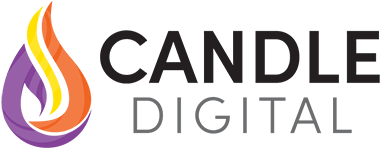Open source software for online learning: The pros and cons

If you’re considering taking your training online, you’ve probably already looked at the different platforms and technology you could use for this.
At Candle Digital, we work with training providers looking to take their expertise online, either for the first time or looking to get better results from their first attempt.
After we’ve helped our clients tease out how they can take their training online, the next step is choosing the technology they’ll use to support their online learning product. With many different options out there, it’s not surprising that clients can find it confusing.
Training providers often use a Learning Management System (LMS) to put their training online. These platforms allow learners to access your training and expertise while giving you the ability to track progress and administer their programmes.
Learning Management Systems tend to fall into two camps: open source or closed source. But which is best? (Hint: this depends on various factors!)
Before we dive into the pros and cons of each type of LMS, let’s define them:
Open Source Learning Management Systems
Open source software agreements licence anybody to freely modify the source code, use it for their own purposes and enhance it for their specific needs.
Open source software is typically created by a community of developers and organisations that incrementally add new features and code over time. They are typically hosted on a company’s own servers.
Some typical examples of open source LMS include Moodle and WordPress (with LMS plug-ins such as LearnDash that add specific learning features).
Closed Source Learning Management Systems
A closed source LMS can’t be freely modified. Only those who made the software can access and change the source code.
Users must purchase a licence to use the software, typically on a per user per month basis, or when large volumes of users are required (typically 500+) commercial options are available.
The software is usually cloud-based – in essence, you’ll use a website to upload and manage your content and learners. All hosting is provided and managed by the vendor.
Closed source solutions are typically aimed at and suited to larger companies looking to deliver internal training and performance management solutions within their own workforce. But smaller training providers can also use them for their clients.
Typical examples of closed source LMS include, Learnupon, aNewSpring, Litmos and iSpring Learn.
What are the pros and cons of each type of LMS?
First of all, it’s important to note that no option is the ‘best’. It’s more about which approach is more suited to your needs (both now and in the future), who will be using the platform, and your capabilities and appetite to manage the software.
However, we’ve found that there are distinct pros and cons for each type of LMS:
Open Source: Advantages
-
No licence fees
An obvious benefit of open source software is that there are no licence fees to use and tailor it to your needs. (However, that doesn’t mean it’s ‘free’… more on this shortly.)
-
You’re not reliant on a specific vendor
The main open source platforms, like Moodle and WordPress, are widely used so there are plenty of vendors and developers who can help you maintain the software after you’ve begun to use it. This means you’re not tied to a niche platform where only one specific vendor looks after it. However if you go down the open source route, ensure you choose a solution that is mature and that is in common use – you don’t want to start integrating an LMS into your business that very few are developing or can support.
-
No increasing user costs as demand increases
Other than infrastructure considerations (such as hosting) there are no additional marginal cost for each additional learner using the LMS. You may need to pay ongoing costs for the support and maintenance of your platform, but these should be largely consistent over time.
-
Flexibility
As your business develops and grows, so can your online learning offering, as you have the ability to modify the platform to suit your needs.
You also have the flexibility to work with additional third-party software that can enhance the learning experience or your administrative functions. These often come in the form of plug-ins that can be ‘bolted on’ to your learning platform.
Open Source: Disadvantages
-
Higher initial investment
Although there are no licence fees to use open source software, it typically requires a higher up-front investment in terms of finance and time.
You’ll need to find someone to help you identify how the platform will be used within your organisation and pay them to install, configure and tailor this to your needs.
-
Greater owner responsibility
The ultimate responsibility for the smooth running of the learning platform lies with the business owner.
This may create a reliance on a third party to support the upkeep, maintenance and development of the platform. Alternatively, you may need to bring in internal resources and skill sets to provide this for you.
Over the years, we’ve heard a lot of misleading rumours about other disadvantages of open source software. We’ve debunked the 4 most common myths in this blog.
Closed Source: Advantages
-
Smaller initial financial investment
Typically, most closed source LMS providers operate a commercial model where you pay for the number of users you enrol on the system.
In the beginning, you may only need a handful of ‘administrator’ accounts to configure the system to your needs and add your content, so there isn’t the same initial expense that comes with an open source LMS.
The vendor probably provides the same technology for many different customers, so there are minimal costs for them to set you up (and, of course, they want you to use their platform).
-
Fewer development costs
Many proprietary software platforms have plenty of functionalities pre-built into them, reducing development costs.
-
No need to worry about technical infrastructure
You don’t have to concern yourself with the technical infrastructure of a closed source platform as technical changes are looked after by the vendor and incorporated into your licence fees.
This is great if you’re looking for a hands-off solution with no technical headaches.
Closed Source: Disadvantages
-
Potential high costs of the “land and expand” model
Closed source solutions are hosted by the vendor and typically operate a “land and expand” business model. This is when the vendor wants their platform to be the only learning platform you use. They grow their revenue as you increase the number of learners using the platform. It’s very similar to the razor market where, once you have the razor, you have to purchase specific branded blades.
-
Reliance on one vendor
Once your customers have started using your learning product, it can be difficult to switch smoothly over to another vendor, platform or type of software. Your content and learners are all within the vendor’s platform and, as it’s not in their commercial interest for you to move, you might find it more difficult than you imagined.
-
Functionality restrictions
You’re restricted by the functionality the vendor chooses to develop. Their development roadmap is likely to be influenced by their larger customers, or the requests with the most votes, which may not be the same developments you want.
Often this technological ceiling isn’t noticeable until you have a larger number of customers and want to provide bespoke or more flexible offerings.
What do we recommend?
At Candle Digital, we describe ourselves as ‘technology neutral’. This means we’re not tied into using one specific LMS with our clients, whether it’s closed or open source.
We help training providers choose the platform that’s right for their business and the learning product they want to develop.
For the commercial training providers we typically work with, an open source solution is often the best candidate for the job.
This is because they usually:
- Want to develop their own asset from scratch
- Want the flexibility to adapt the platform to their needs, e.g. their style of delivery or external accreditation requirements
- Are wary of escalating costs as the business expands
- Want to control and own their own data in the event that their software supplier closes down or sells their software to another company
For the reasons above, most of our clients opt for an open source solution. Those that don’t often do so because of the higher initial investment costs, and the quicker speed to market that a closed solution could provide.
If up-front costs are a concern, it can make sense to use closed source software first as a way to test the market for your online learning product. But be aware that costs can stack up once your product gets off the ground due to the ‘land and expand’ licencing model.
We hope this summary helps you make a better decision! If you need more help with deciding which platform to use for your online learning get in touch with us to discuss your options.
Fresh Insights Direct to Your Inbox
Enjoyed this article?
Join the Candle Digital Mailing List
You’ve Mastered Your Craft. Now Scale It.









